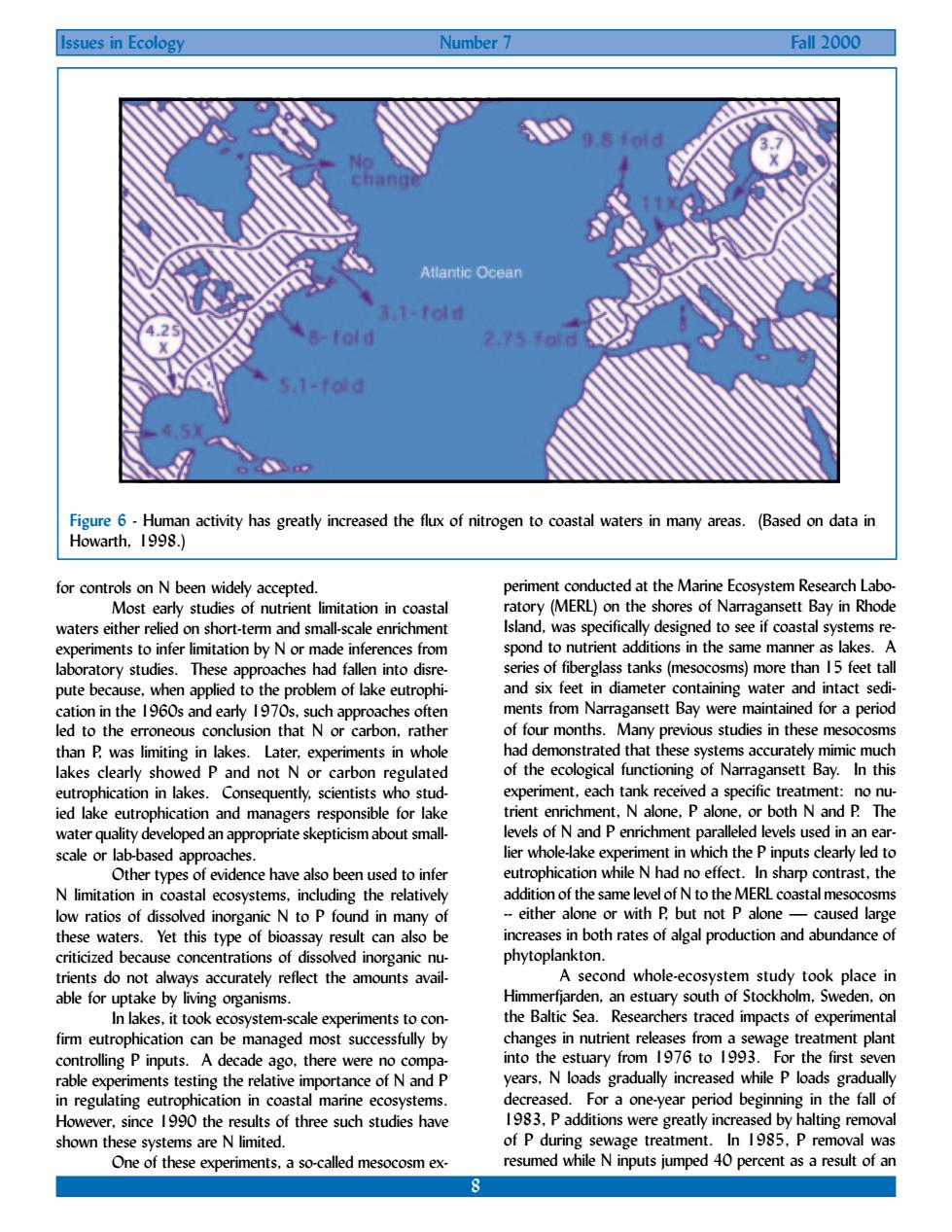正在加载图片...

Issues in Ecology Number 7 Fall 2000 9.8 fold Atlantic Ocear 3.1-fold 8-fold 275 5.1-fold 199 an activity has greatly increased the flux of nitrogen to coast waters in many areas. (Based on data in for controls on N been widely accepted. periment conducted at the Marine Ecosystem Research Labo Most early studies of nutrient limitation in coastal ratory(MERL)on the shores of Narragansett Bay in Rhode waters either relied on short-term and small-scale enrichment Island.was specifically designed to see if coastal systems re 7RpS spond t nutnent additions in the same erglass lanks (mes pute because.when applied to the problem of lake eutrophi- an nsett Bay than P was limiting in lakes.Later,experiments in whol lakes clearly showed P and not N or carbon regulatec onsequently,scientist who stud ager or lak an appropriate skepticism about smal hich the p in approa dence have a ontrast.th sys thes of d either alone or with p hut not p alone caused laro this increases in both ratesof agal production and abundanceof phytoplankton. trients do not ab refle the A second whole-ecosvstem study took nlace in able for uptake by li Himmerfjarden,an estuary south of Stockholm.Sweden.on In lakes it took e stem-scale evn iments to con the Baltic Sea.Researchers traced impacts of experimental firm eutrophication can be managed most 6 changes in nutrient releases from a sewage treatment plant controlling P inputs.A decade ago.there w into the estuary from 1976 to 1993. For the first sever rable experiments testing the relative imp oortance of Nand P years.N loads gradually increased while P loads gradually in regulating eutrophication in coastal marine ecosystems. decreased.For a one-year period beginning in the fall of However.since 1990 the results of three such studies have 1983,P additions were greatly increased by halting removal shown these systems are N limited. of P during sewage treatment.In 1985.P removal was One of these experiments.a so-called mesocosm ex- resumed while N inputs jumped 40 percent as a result of ar 8 Issues in Ecology Number 7 Fall 2000 for controls on N been widely accepted. Most early studies of nutrient limitation in coastal waters either relied on short-term and small-scale enrichment experiments to infer limitation by N or made inferences from laboratory studies. These approaches had fallen into disrepute because, when applied to the problem of lake eutrophication in the 1960s and early 1970s, such approaches often led to the erroneous conclusion that N or carbon, rather than P, was limiting in lakes. Later, experiments in whole lakes clearly showed P and not N or carbon regulated eutrophication in lakes. Consequently, scientists who studied lake eutrophication and managers responsible for lake water quality developed an appropriate skepticism about smallscale or lab-based approaches. Other types of evidence have also been used to infer N limitation in coastal ecosystems, including the relatively low ratios of dissolved inorganic N to P found in many of these waters. Yet this type of bioassay result can also be criticized because concentrations of dissolved inorganic nutrients do not always accurately reflect the amounts available for uptake by living organisms. In lakes, it took ecosystem-scale experiments to confirm eutrophication can be managed most successfully by controlling P inputs. A decade ago, there were no comparable experiments testing the relative importance of N and P in regulating eutrophication in coastal marine ecosystems. However, since 1990 the results of three such studies have shown these systems are N limited. One of these experiments, a so-called mesocosm experiment conducted at the Marine Ecosystem Research Laboratory (MERL) on the shores of Narragansett Bay in Rhode Island, was specifically designed to see if coastal systems respond to nutrient additions in the same manner as lakes. A series of fiberglass tanks (mesocosms) more than 15 feet tall and six feet in diameter containing water and intact sediments from Narragansett Bay were maintained for a period of four months. Many previous studies in these mesocosms had demonstrated that these systems accurately mimic much of the ecological functioning of Narragansett Bay. In this experiment, each tank received a specific treatment: no nutrient enrichment, N alone, P alone, or both N and P. The levels of N and P enrichment paralleled levels used in an earlier whole-lake experiment in which the P inputs clearly led to eutrophication while N had no effect. In sharp contrast, the addition of the same level of N to the MERL coastal mesocosms -- either alone or with P, but not P alone caused large increases in both rates of algal production and abundance of phytoplankton. A second whole-ecosystem study took place in Himmerfjarden, an estuary south of Stockholm, Sweden, on the Baltic Sea. Researchers traced impacts of experimental changes in nutrient releases from a sewage treatment plant into the estuary from 1976 to 1993. For the first seven years, N loads gradually increased while P loads gradually decreased. For a one-year period beginning in the fall of 1983, P additions were greatly increased by halting removal of P during sewage treatment. In 1985, P removal was resumed while N inputs jumped 40 percent as a result of an Figure 6 - Human activity has greatly increased the flux of nitrogen to coastal waters in many areas. (Based on data in Howarth, 1998.)�